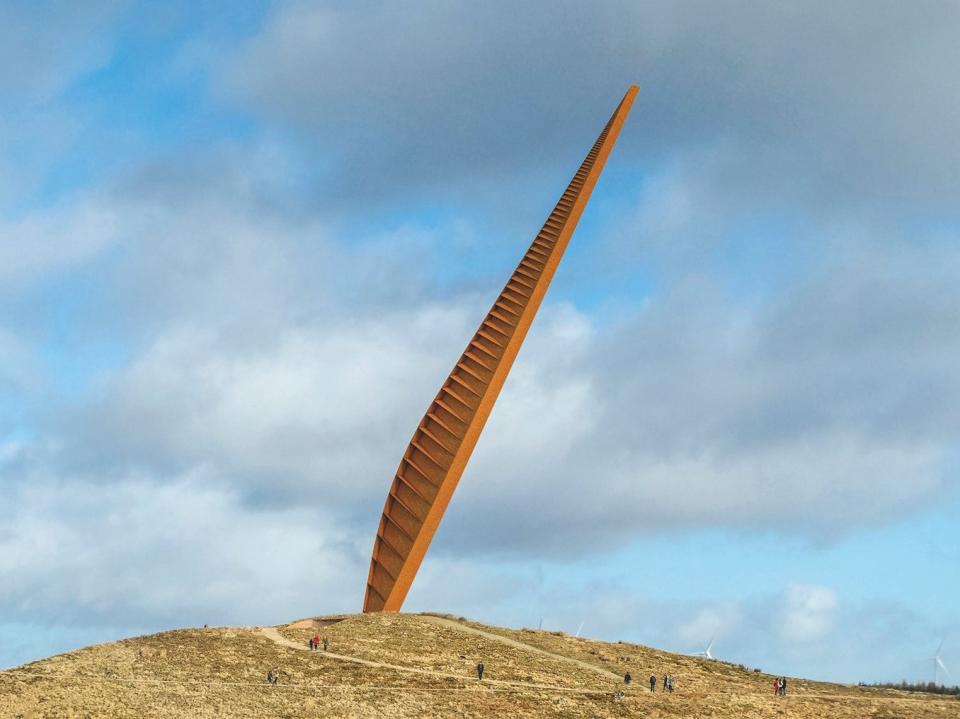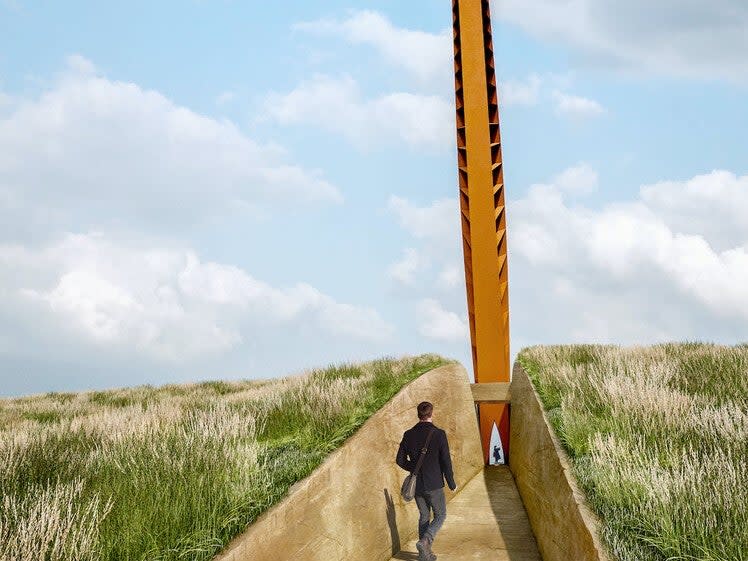Locals outraged at aristocrat’s bid to build 180ft monument to Queen atop Northumberland hill

For advocates, it promises to be an extraordinary tourist attraction in a part of northeast England much in need of a post-coronavirus boost. For opponents, it would be a monstrous folly blotting one of Britain’s most spectacular natural landscapes.
Proposals for a 180ft steel monument to the Queen at the summit of a remote Northumberland hill will go before government planning inspectors next week in the climax of a two-year battle between a local aristocrat and hundreds of nearby villagers.
The skyscraping installation – called the Ascendant: The Elizabeth Landmark and so big it would dwarf Nelson’s Column – is the brainchild of ardent royalist Viscount Devonport who owns the peak, called Cold Law, on which it would stand.
He and supporters say the vast tilting blade, which has been designed by the artist Simon Hitchens, would bring an army of visitors to the area, boost the regional economy and offer a tribute to both the current monarch and the unity of the Commonwealth.
The only problem? It has singularly failed to unite those living in this particular part of the Commonwealth.
More than 400 people have objected to the scheme in writing, while a group formed to fight the proposals – called Keep The Wannies Wild, after the surrounding area – has attracted about 2,000 supporters.
“Monstrous folly” is one description given to the proposal by objectors. An “alien intrusion” is another.
Now, after Northumberland County Council rejected the initial planning application in 2019, an appeal by Viscount Devonport will be decided during a public inquiry beginning next week.
“Whichever way it goes, there are going to be a lot of unhappy people,” says Trevor Thorne, vice-chair of the county council’s planning committee. “People seem to love the idea or hate it but it’s certainly got them talking.”
He himself was one of the few committee members who previously voted for the proposal to go ahead, and he now hopes the appeal succeeds.
“I don’t buy into this idea that it would be a folly,” the Conservative says. “If you look at the designs, I think it would enhance the beauty of the surrounding landscape. It would complement it.”
As chair of the authority’s sub-committee on rights of way, his own remit includes finding ways to attract more people to rural Northumberland – and he reckons such a landmark would do just that.
“The Wannies is such a special place but, beyond the local area, it is a bit of a secret,” he tells The Independent. “Something like this could really draw people here to enjoy that wild beauty.”

Supporters also point out that the installation, which would also include history boards and improved footpaths, is so remote that it would not actually be visible from anyone’s home, while the estimated £3 million cost is to be met entirely by private investors.
An economic impact assessment, drawn up by Viscount Devonport last year, suggests the attraction would generate £1.4 million over a 10-year period. But it adds that the real value may be far greater.
“The major economic impact of large-scale public art is often as a precursor to other regeneration activity,” the report states.
“It is difficult to see what other development the landmark might promote but it would undoubtedly attract local, national and international media attention, from which Northumberland would derive benefits.”
More pointedly, perhaps, proponents highlight how 20,000 people objected to the Angel of the North when it was first proposed. “But that is now part of the fabric of the region,” says Thorne. “It has become a symbol of home for many in the northeast. I think this could be the same.”
The argument is not one, however, that washes with the Keep The Wannies Wild group.
“It’s completely different,” says Mary Ann Rogers, an artist and gallery owner in West Woodburn. “The Angel of the North is in an area designated for urban regeneration and was created by an artist, Antony Gormley, who had undertaken years of research about the area. This is a one-man project in a completely rural and remote region. The comparisons do not stand up.”
She says the massive structure – which the local Kirkwhelpington Parish Council has also called “inappropriate” – would constitute an unnecessary spoiling of one of England’s increasingly few wild landscapes.
“They say this would be a tourist attraction,” she says. “Well, there is not one tourist business around here – and I include myself in that as a gallery owner – who supports this.
“We know people come here because it is wild: climbers, walkers, artists looking for inspiration. They do not come here looking for an enormous huge industrial blot. They would go elsewhere.”
Plus, she adds, there is one more reason why this might not be an ideal place for a monument to the Queen.
“Do you know what Cold Law is called locally?” she asks. “Tit Hill – because of it’s shape. Is it really right to associate the Queen with that?”
It will now be for the government’s planning inspectorate to decide. A ruling is expected in late March.
Read More
Kitchens on wheels and flagstone lounges: How Brits are preparing for a future with floods

 Yahoo Finance
Yahoo Finance 